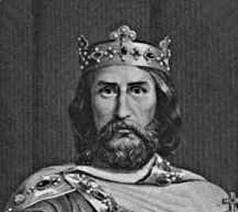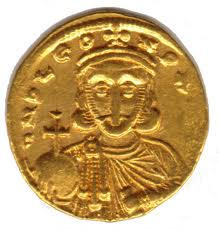|
Leo III, so-called founder of the "Isaurian" dynasty, was not of Asia Minor but was born ca. 680 in Germanicia a.k.a. Marash near Aleppo in the northern corner of the eastern Mediterranean. His original name may have been Konon. According to the chronicles of Theophanes the Confessor, his family was forcefully resettled by Justinian II (685-695) in Mesembria, an ancient Greek town on the coast of Thrace near Bulgaria where he was raised.

On December 25, 800, Pope Leo III crowned Charlemagne emperor. This act established both a precedent and a political structure that were destined to figure decisively in the affairs of central Europe. The precedent established the papal claim to the right to select, crown, and even depose emperors that was asserted, at least in theory, for nearly 700 years.
Leo defended Constantinople against the last Arab siege (717–18), and although he had to contend with Arab attacks in Asia Minor, he succeeded in ending serious Arab threats for nearly two centuries and reorganized the military provinces (themes) of the empire for greater efficiency.

His civil code, the Ecloga, written in Greek rather than in Latin, was a practical handbook that had considerable influence in Byzantium. He is also credited with issuing military, maritime, and rural codes. Leo's attack (726) on devotion to holy images began the long struggle over iconoclasm.
Leo's first military challenge as emperor was to repel the Arab forces under Maslama, who had led an expedition into Asia Minor at the end of 715, and proceeded to besiege Constantinople in 717. Leo III was aided in his defeat of the combined forces of the Arab army, led by Malsama, and the navy led by Sulayman, by the help of the Bulgarian khan Tervel.

Following the example of Patriarch Sergius (610-638) who had carried an icon of Mary around the city walls during the Avar siege of Constantinople in 626, Patriarch Germanus faced the Arab siege with the power of an icon of the Theotokos. Miraculously, the city was saved, though Leo's role in the affair is played down by iconophile sources.
Despite his military successes, the empire suffered territorial losses during Leo's early reign, as well as, a devastating underwater earthquake at Thera and Therasia in 726. These were interpreted by him as a sign of divine displeasure, and as a warning to turn back to the "real protector of the empire in its full greatness," i.e. Christ.
It was at around this time, either in 726 or 730 -- the sources are divided as to whether the ruling patriarch was Germanus or his successor Anastasius -- that he replaced the relief of Christ on the Chalke Gate at the entrance to the imperial palace with a cross bearing the inscription "I drive out the enemies and kill the barbarians."
|

![]()


